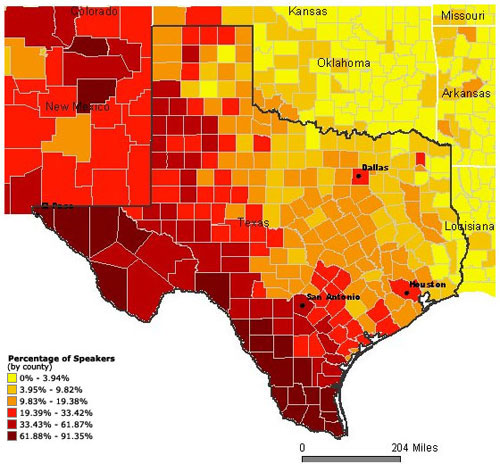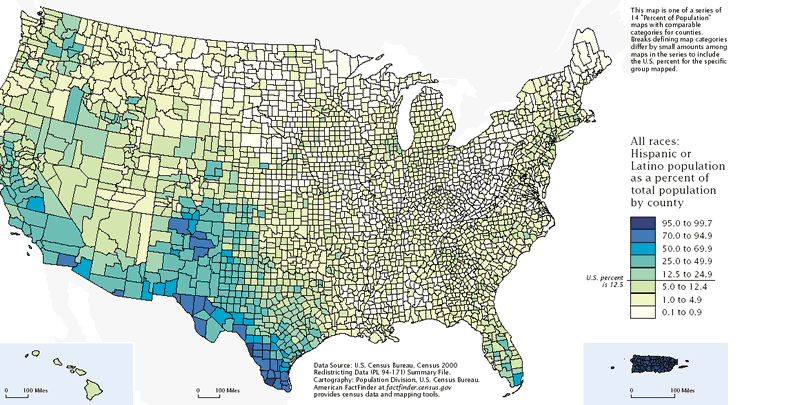August 27, 2006
Spanish in the states
A few days ago, we looked into an article in the Guardian, which stated that "Spanish is fast rising in importance and there are now more Spanish speakers in the United States than English." I speculated that "the Guardian's entire editorial staff is on vacation, and has delegated its duties to the night office-cleaning crew, who are having a little competition among themselves to see who can slip the most extravagant falsehoods into print." But it turned out that it was simply a slip of the pen on the part of the article's author, Prof. Alan Smithers, who explained that "[t]he thought that was in my mind when I wrote that part of the sentence was `there are now more Spanish speakers in some of the United States than English'.
I was still skeptical about this modified statement. I wrote Prof. Smithers for clarification, and he was kind enough to reply.
Many thanks for keeping me posted.
The picture I had in mind was Figure 5 of the US Census 2000 Brief which shows large parts of the States bordering Mexico with 60 per cent or more, or 35.0 to 59.9 per cent, of people, five years and over, who spoke a language other than English at home. Table 4 of the same document lists the top ten areas for Spanish speakers all of which are above 50 per cent reaching as high as 91.9 per cent.
The figures are taken from the 2000 Census and are likely to have been under-estimates since they derive from a question about language spoken in the home rather than mother tongue, and the form could only have been sent to known households with reliance on an honest response. There has also been rapid growth in Hispanic migration since 2000, both legal and illegal.
I, therefore, felt justified in going for a dramatic statement. But since it has attracted attention out of all proportion to its importance in the article (which was about why we in England should not be too bothered by the decline in the learning of French and German in our schools given the increasing interest in Spanish and other languages), it should perhaps have been more qualified - though whether a more academic sentence would have survived the subbing is another matter.
Prof. Smithers is referring to census data like this:
But there's a danger in generalizing too quickly from such maps, as Ben Zimmer pointed out a few months ago. Here's the same data -- proportions of Spanish speakers by county -- graphed for the state of Texas by the excellent MLA language mapping web site:

This certainly makes it look as if at least as many Texans speak Spanish as English. However, many of the counties with the highest percentages of Spanish speakers are thinly populated. If you look instead at a map by number of speakers, a different sort of picture emerges:

This helps explain why the overall population of Texas was found by the 2000 census to be only 25.5% "Hispanic". And as I understand it, this is an ethnic rather than linguistic statistic, and so the proportion of Spanish native speakers would be somewhat lower. Texas has the third-highest state-level "Hispanic" proportion, essentially tied with California at 25.8%, and behind New Mexico at 38.2%. In fourth place is Arizona with 18.8%. (According to estimates of current proportions of Spanish speakers on the MLA site, New Mexico is at 28.76%, Texas is at 27.00% and California is at 25.8%. Note also that the majority of these "Spanish speakers" also speak English "very well" or "well" -- e.g. in California, 5,593,955 out of 8,105,445.)
Prof. Smithers suggests two reasons why today's real proportions might be higher than this: census undercounting and continued immigration. Both are valid points, but I think they're unlikely to rescue his statement.
As for census undercounting, this was investigated carefully by Eugene Erickon, "An Evaluation of the 2000 Census". He estimates that Hispanics were undercounted by about 2.85%, non-Hispanic Blacks by 2.17%, and non-Hispanic Whites by 0.67%. Given these estimates and the state-level percentages given above, it's clear that not even New Mexico is going to get close to 50% Hispanic.
And as for on-going changes, the census bureau estimates that between 1990 and 2000,
The Hispanic population increased by 57.9 percent, from 22.4 million in 1990 to 35.3 million in 2000, compared with an increase of 13.2 percent for the total U.S. population [which was 281.4 in 2000].
If we project the same rates of growth forward for New Mexico and Texas, we'd predict that New Mexico would become 46.3% "Hispanic" by 2010, and Texas would become 32.3% "Hispanic". These proportions would be increased slightly by allowing for undercounting, but not as much as they would be decreased by removing the members of the "Hispanic" category whose native language is not Spanish -- according to the accounts that I've read, that would be many of the second generation and nearly all of the third. [See the 1987 movie Born in East L.A. for the (hilarious but fictional) story of Cheech Marin as a Chicano, born in the U.S. and speaking no Spanish, who is mistakenly deported to Mexico by the U.S. immigration authorities. And way back in 1969, one of my army buddies was a Hispanic guy from San Antonio whose Spanish was not very good, though his ethnic identity was strong.]
So I think it would still have been factually incorrect if Prof. Smithers had written that "there are now more Spanish speakers in some of the United States than English". It would be closer to correct to say that "several of the United States are more than 25% Spanish speaking". Whatever the exact proportions, it's certainly true that many U.S. residents speak Spanish -- which I guess was Prof. Smithers' main point.
[Update (August 28, 2006): I guess some of the Guardian's editorial staff have returned from vacation early, and so there is now a correction here, three days later and (of course) not linked from the original article, which remains in place, unchanged, to enlighten future readers... ]
Posted by Mark Liberman at August 27, 2006 12:07 PM